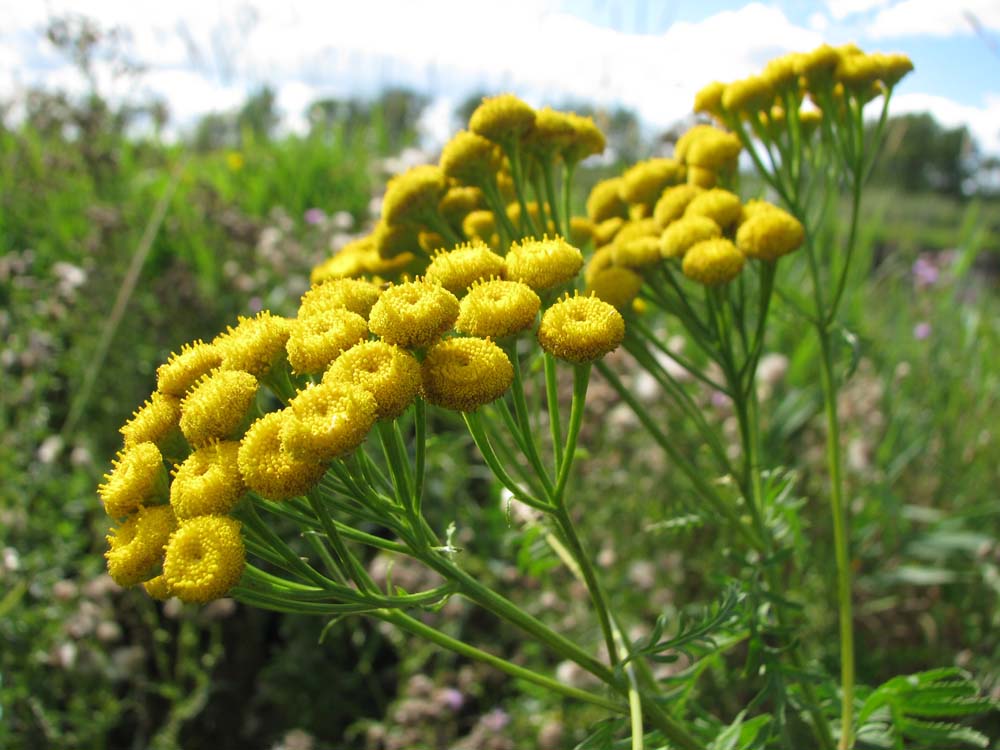Weed Of The Week #12 - Common Tansy (Tanacetum vulgare)

Weed Of The Week #12 - Common Tansy (Tanacetum vulgare)
Noxious Under Alberta’s Weed Control Act
Submitted By Kelly Cooley, CoolPro Solutions
Common Tansy is a non-native, bushy, creeping rooted perennial that varies between a few inches and up to 1.5 metres (5 feet) tall from the Aster (Asteraceae) Family. This species prefers disturbed, well drained rocky or loamy soils in full view of the sun. In southwest Alberta it seems to show up on our creek and river banks and adjacent riparian areas, forming dense colonies and displacing preferred native plants along these stream banks. It also does well in adjacent pastures and other disturbed areas near these rivers and creeks.
Seeds from Common Tansy move readily in flowing water, depositing on the stream banks to germinate and spread. A single plant can produce anywhere between 2,000 and 50,000 seeds! Seeds may also be spread by birds and perhaps other wildlife, and in infested soil & gravel and the equipment used to move it. Once established, Common Tansy spreads into colonies via its short but extensive creeping root crowns. These rhizomes also send out lateral roots (rhizomes) that germinate new Tansy shoots above-ground. New shoots can also develop from fragments of these rhizomes.
The shoots and leaves of Common Tansy are a dark green, and quite distinctly fern-like. Leaves are deeply divided into leaflets with toothed margins. Leaves are alternately arranged on green and purple-red stems, and there are several branched leaves per stem. These leaves have quite a strong smell when crushed.
Flowering heads of Common Tansy develop in July of the second and subsequent years of plant growth into densely packed, flat-topped clusters of between 20 -200 yellow, button-like flowers atop the stems. These flowers mature into seeds in the fall, but often only 10-20% are viable at season’s end. Dead stalks of Common Tansy often retain their seeds through the winter, and those that fall the following spring germinate at a rate of 70-80%. Seeds may remain viable for up to a quarter century.
Best results to control Common Tansy involve using more than one control method, often in combination. Seedlings can be controlled with selective broad-leaved herbicide treatments of first year rosettes and early spring second year plants! If treating second year plants with herbicides, do so well prior to flowering, ensure the entire plant is thoroughly covered, and add a surfactant to help penetrate through the leaves and stems.
Hand pulling and bagging seedling plants in moist soil can help, but make sure to get as much of the root as possible. Wear gloves, as the oils from this plant can be very irritating. Once the plant is well into flowering (late July and August), cut off, bag, and burn the flower clusters that contain the clustered flowers and mature seed capsules. After removing the flower clusters, the remaining leaves and stems can be treated with a selective broadleaf herbicide in the fall to help discourage regrowth.
Mowing and grazing has met with limited results as the terrain for this plant is often wet and difficult to navigate, and the plants are unpalatable to most livestock. If possible, regular mowing can reduce seed production and wear out root reserves. At present, there is no viable biological control species for Common Tansy.
Dead stalks topped with intact seed clusters should be collected, bagged, and burned at any time, as they are likely viable.
More information can be found in the Common Tansy Fact Sheet from the Alberta Invasive Species Council, and you can report this invader yourself using their free EDDMapS application on your mobile device. For local control options for Common Mullein, please contact our Agricultural Fieldman at 403-339-8741.
Photo Credits:
Kelly Cooley, CoolPro Solutions
Alberta Invasive Species Council
Sarah Schumacher, Wheatland County
Todd Green, County of Newell
Maureen Vadnais
Return to News & Events



